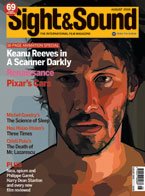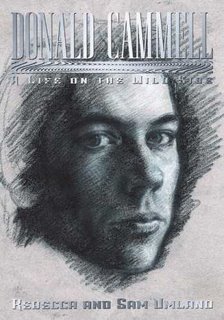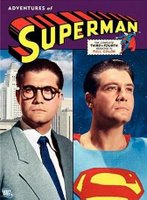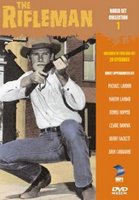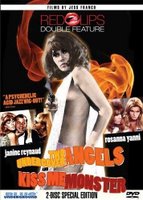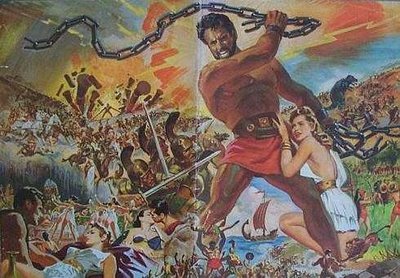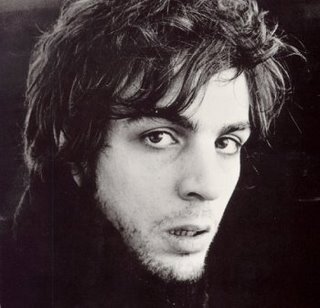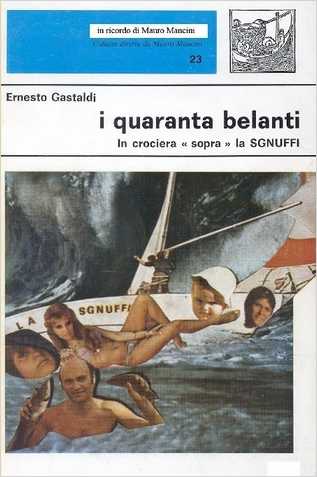We're now reaching a point with the Bava book that Donna and I have long awaited. Donna plans to finish her work on the bulk of the interior by this weekend, and we're going to spend Saturday and Sunday finally laying out the front and back matter. Next week, I have a few deadlines and am also scheduled to be proofreading the last 700 or so pages of the Bava book one last time, so for the immediate future, I'm barred from doing what my heart yearns for me to be doing: finishing my novel-in-progress, on which I made substantial progress last week. While my unborn book weeps inside me from the latest in a series of shows of neglect, I've had to decide how I'm going to spend this waiting period, knowing that, whatever I do, I may be pulled away for Bava consultation at any time. The answer was unavoidable, especially with a wife who always has such suggestions at the ready: My office has been a hell-hole for too long. I really should use this time to get my environment in order.
I know in my heart-of-hearts that I respond well to orderliness; a neat and attractive environment is more welcoming and uplifting. However, my mind is usually juggling a number of things at once: the book, my novel, our current issue, the next couple of issues, my extracurricular deadlines, this blog, etc. I have a habit of writing notes to myself, as well as epigrams, DVD info for reviews, on little index cards are leaving them all over the house. (I just noticed the other night that the "Winsor Concerto" from THE WHIP AND THE BODY is briefly heard in Paul Naschy's THE MUMMY'S REVENGE, a film evidently scored with CAM library tracks, so I made a note of that.) I leave these cards wherever I happen to write them, with the idea of taking them with me on my next trip upstairs, where I intend to log them into my computer, where they can add to whatever I'm working on. Somehow, this seldom happens and each card ends up joining many others in a stack that I tuck just north of my keyboard until the fabled day when they'll get processed. Some might say this is procrastination, but it's more like "I need a secretary." But, as Donna says, if we had a secretary, I couldn't work in my bathrobe.
Organizing my office has been my ongoing project for the last three days, and it still looks like a cross between a train wreck and a yard sale. In a stack of papers and magazines, I actually found a homemade birthday card which Donna had printed for me on a dot-matrix printer, welcoming me to "the elite group of people who are now 35," an incriminating illustration of how lax I've been about filing things away. (I'm a bit older now.) An important preliminary task was cataloguing all my uncatalogued CD-R and DVD-R binders, which is a task I can only stand to perform five hours at a time, so it took a couple of days. With those binders finally off my floor, and placed on shelves (recently cleared of laserdiscs) in our living room, the next major task was weeding out my office bookshelves, which cover two walls from floor to ceiling. Though toiling in an air-conditioned room and dressed for comfort, I worked up quite a sweat deciding which of the books could be boxed up and which could be dispensed with. At this stage of my life, I figure that if I'm putting books into boxes, I might as well lower them into the ground as well. There are always going to be so many books in front of me that I'll almost certainly never have need to seek my old file-aways out. The process of removing books from these shelves, adding books finally taken off the floor, and reorganizing everything alphabetically took a good five to six hours. At the end of the work, I had two shortish stacks of books to be taken to the attic and three stacks of discarded books that rose as high as my thigh.
My bookshelves looked infinitely tidier to me, so I called Donna in to admire my progress. I showed her where to stand to get the best vantage point (as if my cluttered floor offered her many options). She looked at the shelves and said, "You know, the sad thing about this is that, already, you have no room to grow -- so, if one more book comes into this room, it's going on to the floor and the whole nightmare starts over again."
That's the last thing I wanted to hear, partly because I knew at once she had a point. As they now are, the books are pretty tightly packed and there are a few books resting on top of other books. A section of one shelf is filled with smaller paperbacks that should be somewhere else, and another section of another shelf is stacked with books incoming for review. These need to be shipped out to reviewers. One entire shelf is occupied by music-related books, which Donna thinks should be moved somewhere else (preferably boxed away), but these are what I reach for most commonly, when I need a break from movie-related writing. Actually, when I'm editing VW full-time, I read so much movie-related writing that I sometimes wonder why I keep any of these books at all. After a full day of reading/editing film reviews and features, I'm going to kick back and relax with more film reviews and analysis? I have days when I'd like to box all these movie books away and bring my novel collection down from the attic, where they've been gathering dust for more than a decade. Dipping into other writers' fiction might be just the tonic I need; I shouldn't have to worry about reading them from cover to cover, if I haven't the time for it. After all this time, I've sincerely forgotten which novels I own, as they've mostly flowed together down the rivers of forgetfulness with the ones I've sold or merely borrowed from the library.
"How many of these are you really going to refer to?" Donna asks, nodding at the formidable barriers of bound print I have amassed between myself and Death. Probably not many. I now use
www.dictionary.com for my dictionary and thesaurus needs, but having an actual three-dimensional Webster's gives one the power to browse and actually add words to one's vocabulary. "How often do you do that?" Well, I once had a life of relative leisure in which I could do things like that, and though I don't do it much (okay, at all) nowadays, I am not prepared to admit that those days are gone and will not be returning. Yes, I admit that the need I feel to hold on to some of these books is rooted in the self-delusion that, someday, time might decide to move backwards.
Some of the books on my walls are important reference tools; some are classic references past their prime (emphasis on "classic," so they stay within reach); some were written by friends and are warmly inscribed; some I wrote myself or contributed to; some I am unlikely to read but are just cool to have and admire; and others I've read and loved, so I feel the need to keep them visible in my daily life, both as memento and source of invigorating inspiration. If I sincerely had to make a hard and realistic decision based on how often I might actually open and use these books, surely many more could be taken down... but they'd have to go somewhere else in our Incredible Shrinking House, and there simply isn't anywhere else for them to go. Certainly not downstairs, and upstairs (the attic) is crowded enough. And, as an author of books, I have to insist on the right to display what I've done in my own house, though there is little need for me to read them again after publication.
Books are hard things to throw away and, trouble is, they are even harder to sell. You can't get even half of what they're worth in second-hand stores; the last time I tried, I ended up leaving two entire boxes of turned-down books at the store rather than lug them back home to my attic. (I think the book dealer was banking on me doing this, and I felt so cheated by this ordeal, I've never returned to that once-favorite book store.) Until I can decide what to do with them, it looks like they'll continue to take up residence on my office floor, but perhaps I can clear a corner where they can gather dust until new homes can be found for them.
Increasingly, my life can be described as a war with stuff: the old stuff, the incoming stuff, the stuff that needs to be processed, the stuff that needs to be shipped out to contributors, the stuff I love, the stuff I've outgrown, the cool but otherwise unfunctional stuff, the sentimental stuff, the stuff that's cute, the heirloom stuff, the broken stuff that needs to get fixed or replaced -- all of it demanding a place in my life and regular dustings and refusing to be thrown away. With each new thing I acquire, I have the feeling of adding soldiers and rations and ammunition to the enemy, but my refusal to stop is as steadfast as my refusal to surrender.
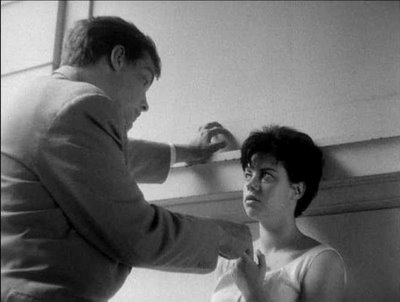 THE BAKERY GIRL OF MONCEAU (1962) was shot in 16mm, and looks surprisingly crisp and sensual in this presentation.
THE BAKERY GIRL OF MONCEAU (1962) was shot in 16mm, and looks surprisingly crisp and sensual in this presentation. SUZANNE'S CAREER (1963): Also shot in 16mm, this film has the grainiest-looking transfer, but much of the film was shot in low-light interiors and it actually looks quite good, so all is forgiven.
SUZANNE'S CAREER (1963): Also shot in 16mm, this film has the grainiest-looking transfer, but much of the film was shot in low-light interiors and it actually looks quite good, so all is forgiven. MY NIGHT AT MAUD'S (1969): How many black-and-white DVD transfers have you viewed that can compare to savoring a rich dessert? This may be the most ravishing black-and-white DVD transfer I've ever experienced. In shots like these, of Françoise Fabian, you can actually sense how warm her skin is and can almost read her thoughts.
MY NIGHT AT MAUD'S (1969): How many black-and-white DVD transfers have you viewed that can compare to savoring a rich dessert? This may be the most ravishing black-and-white DVD transfer I've ever experienced. In shots like these, of Françoise Fabian, you can actually sense how warm her skin is and can almost read her thoughts. LA COLLECTIONEUSE (1967): This film was shot third but always intended as the series' fourth segment, as Rohmer wanted the stories split between three black-and-white and three color. Fox Lorber's DVD of this title was ugly trash. Criterion makes the colors and textures of leap off the screen with remarkable sharpness and clarity. Of all the films in the Rohmer set, this is the most surprising transfer and the most gorgeous of the color films. The young lady seen here, Haydée Politoff, later co-starred in Paul Naschy's COUNT DRACULA'S GREAT LOVE and can be seen reading a paperback of DRACULA in this movie.
LA COLLECTIONEUSE (1967): This film was shot third but always intended as the series' fourth segment, as Rohmer wanted the stories split between three black-and-white and three color. Fox Lorber's DVD of this title was ugly trash. Criterion makes the colors and textures of leap off the screen with remarkable sharpness and clarity. Of all the films in the Rohmer set, this is the most surprising transfer and the most gorgeous of the color films. The young lady seen here, Haydée Politoff, later co-starred in Paul Naschy's COUNT DRACULA'S GREAT LOVE and can be seen reading a paperback of DRACULA in this movie.  CLAIRE'S KNEE (1970): This probably isn't the best frame for showing off the transfer's vibrant colors and amazing sense of depth, but I love this shot of Laurence de Monaghan, so that's what you get. A wonderful presentation of a delightful film.
CLAIRE'S KNEE (1970): This probably isn't the best frame for showing off the transfer's vibrant colors and amazing sense of depth, but I love this shot of Laurence de Monaghan, so that's what you get. A wonderful presentation of a delightful film. LOVE IN THE AFTERNOON (aka CHLOE IN THE AFTERNOON, 1972): The colors and textures in this film really pop, and when Zouzou strips down to her black chemise, for the first time on video, you can actually see through the sheer fabric. Based on my viewings of this film in 16mm and on Fox Lorber DVD, it was never a favorite of mine, but now I find it the second best of the Moral Tales, after MY NIGHT AT MAUD'S.
LOVE IN THE AFTERNOON (aka CHLOE IN THE AFTERNOON, 1972): The colors and textures in this film really pop, and when Zouzou strips down to her black chemise, for the first time on video, you can actually see through the sheer fabric. Based on my viewings of this film in 16mm and on Fox Lorber DVD, it was never a favorite of mine, but now I find it the second best of the Moral Tales, after MY NIGHT AT MAUD'S. 









